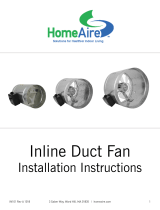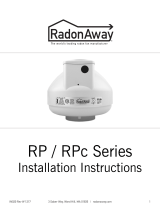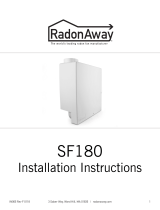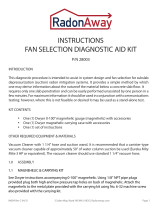
IN009 Rev O 1121 43 Saber Way, Ward Hill, MA 01835 | radonaway.com
4.0 BACKDRAFT DAMPERS
Backdraft dampers allow airow in only one direction preventing cold/hot drafts from entering the vented area and
minimize possible condensation and icing within the system while the fan is not operating. Backdraft dampers
are highly recommended at each intake grille for bathroom ventilation in all cold climate installations. Installation
instructions are included with Spruce backdraft dampers.
5.0 ELECTRICAL WIRING
All wiring must be performed in accordance with the National Fire Protection Association’s (NFPA) ”National Electrical
Code, Standard #70” current edition for all commercial and industrial work, and state and local building codes.
All wiring must be performed by a qualied and licensed electrician. A Ground Fault Interrupter (GFI) circuit is not
required in most installations; check your local codes. Ensure that all exterior electrical boxes are outdoor rated and
properly sealed to prevent water penetration into the box. A means, such as a weep hole, is recommended to drain
the box. Note that the fan is not intended for connection to rigid metal conduit.
6.0 APPLICATIONS
Suitable for general ventilation, bathroom venting, fresh air supply, duct boosting, building pressurization, etc.
RV Series Fans not suitable for kitchen range hood venting.
7.0 INSTALLATION
Step 1: Install Mounting Bracket as shown (Fig. 4). Insert Grommets into slots in Mounting Bracket.
Orient the Electrical Box relative to Mounting Bracket as required. Attach the fan to the Mounting Bracket with
3 #10 self-tapping screws, provided. Avoid over tightening screws.
Step 2: Select location for fan mounting. A location 2/3 along the ducting, a minimum of 10 feet away from the
inlet vent to the fan or the T/Y of a multi-intake system- will provide the quietest operation. Fan should be mounted
vertically to prevent moisture from accumulating in the fan housing. Attach bracket to mounting structure with the
1 1/4” screws provided (Fig. 5).
Step 3: Connect ductwork between fan inlet and area to be vented through inlet grille (Fig. 6). Flexible, nonmetallic
ducting is recommended for quietest operation and easiest installation. Insulated exible ducting is highly
recommended for bathroom ventilation in all cold climate installations. Metal worm drive clamps, spring clamps,
and adjustable plastic ratchets are recommended for connection of ducting. Silicone caulk or duct tape may be
used for additional sealing. Duct tape should be used to retain insulation.
Step 4: Connect inlet grille(s) (Fig. 7). An optional backdraft damper may be installed in the inlet grille to prevent
cold air from backing into the inlet, prevent conditioned air from escaping and also prevent condensation from
forming inside the ductwork. Backdraft dampers are highly recommended at each intake grille for bathroom
ventilation in all cold climate installations.
Step 5: Connect outlet of fan to outside vent (Fig. 8). The outside vent may go through the roof, sidewall or soft
as desired. Flexible, nonmetallic ducting is recommended for quietest operation and easiest installation.
Insulated exible ducting is highly recommended for bathroom ventilation in all cold climate installations.




















